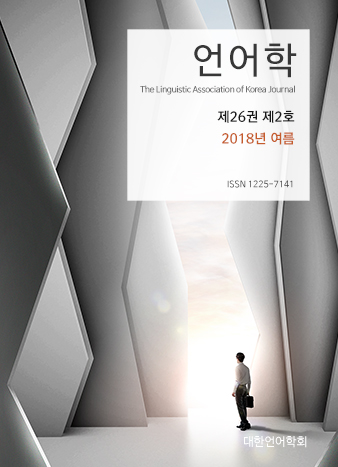대한언어학회 전자저널

-
The Why-not Construction in Korean: A Direct Interpretation Approach
-
L2 Acquisition of Raising Revisited: The Role of the Experiencer Phrase
-
How Universities in Korea and the US Position Themselves in Brochures
-
A Study of Learning Strategies in a Flipped Class Based on Logistic Regression Analysis
-
A Study on the Effects of a TETE Class on English Learners’ Motivation and Anxiety
-
Oral versus Written English Grammar: Evidence from Korean Adult Learners’ Data
-
The Effects of Dictogloss Tasks on EFL Learners’ Syntactic Development
26권 2호 (2018년 6월)
- Oral versus Written English Grammar: Evidence from Korean Adult Learners’ Data
-
In Lee
Pages : 133-146
Abstract
Keywords
# English ditransitive verb # sensitivity to Focus # sensitivity to Tense
References
- Aoun, J., & Li, Y. A. (1989). Scope and constituency. Linguistic Inquiry, 20(2), 141-172.
- Baker, C. L. (1979). Syntactic theory and the projection problem. Linguistic Inquiry, 10(4), 533-581.
- Bencini, G. M. L., & Goldberg, A. E. (2000). The contribution of argument structure constructions to sentence meaning. Journal of Memory & Language, 43, 640-651.
- Carmi, G. (2003). A circle of friends. New York: Star Bright Books, Inc.
- Erteschik-Shir, N. (1979). Discourse constraints on dative movement. In T. Givon (Ed.), Syntax and semantics 12: Discourse and syntax (pp. 441-167). New York, NY: Academic Press.
- Goldberg, A. E. (1995). Constructions: A construction grammar approach to argument structure. Chicago, IL: The University of Chicago Press.
- Gropen, J., Pinker, S., Hollander, M., Goldberg, R., & Wilson, R. (1989). The learnability and acquisition of the dative alternation in English. Language, 65(2), 203-257.
- Hong, H.-T. (2003). The English ditransitive construction. The Jungang Journal of English Language & Literature, 45(4), 201-216.
- Jun, J. S. (2006). Lexical derivation of triadic dative verbs in English. Discourse and Cognition, 13(3), 189-207.
- Larson, R. K. (1988). On the double object construction. Linguistic Inquiry, 19(3), 335-391.
- Lee, I. (2017). How sensitive are Korean adult learners of English to 'Focus' and ‘Tense'? In Proceedings of the SMOG․LAK․KGGC 2017 Joint Conference, 104-108.
- Lee, I. (2018). Oral vs. written English grammar: Evidence from Korean adult learners' data. In Proceedings of the 2018 KAPEE International Conference, 103-107.
- Lee, J.-M. (2009). Yeongeo ‘give' dongsaeui tadongseong (’Transitivity of ‘give' in English’). New Korean Journal of English Language & Literature, 51(1), 303-323.
- Lee, J.-H., & Kim, H. M. (2011). The L2 developmental sequence of English constructions and underlying factors. Korean Journal of English Language & Linguistics, 11(3), 577-600.
- Pinker, S. (1989). Learnability and cognition: The acquisition of argument structure. Cambridge, MA: MIT Press.
- Shan, R., & Hong, S. (2009). On ditransitive constructions: A neo-transformational approach. The Journal of Studies in Language, 25(3), 575-599.
- Shin, G.-H. (2010). On the contribution of argument structure constructions to sentence meaning for Korean learners of English. English Teaching, 65(4), 209-227.
- Tak, K. (1999). ijung mokjeogeo gumungwa chojeom ('Ditransitive Construction and Focus'). Yeongeoyeongmunhak (English Language & Literature), 18(2), 183-198.
- Year, J., & Gordon, P. (2009). Korean speakers’ acquisition of the English ditransitive construction: The role of verb prototype, input, distribution, and frequency. The Modern Language Journal, 93(3), 399-417.
- Korea TOEIC Committee. (2016, April). 2015nyeon TOEIC TOEIC Speaking pyeonggyun seongjeokeun? (‘Average scores of TOEIC, TOEIC Speaking in 2015). TOEIC Newsletter, 93. Retrieved May 1, 2018, from http://exam.ybmnet.co.kr/newsletter/index.asp?nid=2&pageno=2.